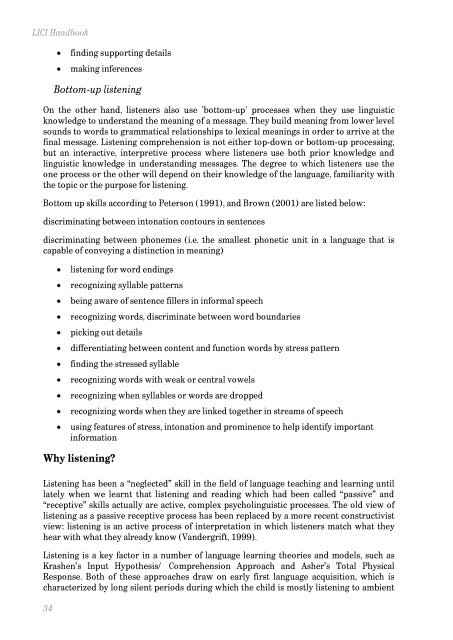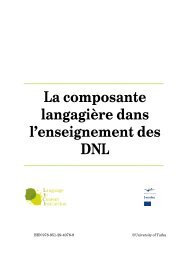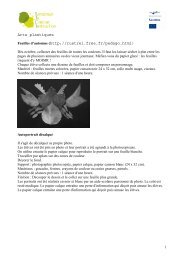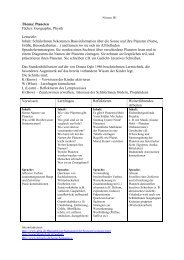Language in content instruction - LICI Project
Language in content instruction - LICI Project
Language in content instruction - LICI Project
Create successful ePaper yourself
Turn your PDF publications into a flip-book with our unique Google optimized e-Paper software.
<strong>LICI</strong> Handbook<br />
34<br />
f<strong>in</strong>d<strong>in</strong>g support<strong>in</strong>g details<br />
mak<strong>in</strong>g <strong>in</strong>ferences<br />
Bottom-up listen<strong>in</strong>g<br />
On the other hand, listeners also use 'bottom-up' processes when they use l<strong>in</strong>guistic<br />
knowledge to understand the mean<strong>in</strong>g of a message. They build mean<strong>in</strong>g from lower level<br />
sounds to words to grammatical relationships to lexical mean<strong>in</strong>gs <strong>in</strong> order to arrive at the<br />
f<strong>in</strong>al message. Listen<strong>in</strong>g comprehension is not either top-down or bottom-up process<strong>in</strong>g,<br />
but an <strong>in</strong>teractive, <strong>in</strong>terpretive process where listeners use both prior knowledge and<br />
l<strong>in</strong>guistic knowledge <strong>in</strong> understand<strong>in</strong>g messages. The degree to which listeners use the<br />
one process or the other will depend on their knowledge of the language, familiarity with<br />
the topic or the purpose for listen<strong>in</strong>g.<br />
Bottom up skills accord<strong>in</strong>g to Peterson (1991), and Brown (2001) are listed below:<br />
discrim<strong>in</strong>at<strong>in</strong>g between <strong>in</strong>tonation contours <strong>in</strong> sentences<br />
discrim<strong>in</strong>at<strong>in</strong>g between phonemes (i.e. the smallest phonetic unit <strong>in</strong> a language that is<br />
capable of convey<strong>in</strong>g a dist<strong>in</strong>ction <strong>in</strong> mean<strong>in</strong>g)<br />
listen<strong>in</strong>g for word end<strong>in</strong>gs<br />
recogniz<strong>in</strong>g syllable patterns<br />
be<strong>in</strong>g aware of sentence fillers <strong>in</strong> <strong>in</strong>formal speech<br />
recogniz<strong>in</strong>g words, discrim<strong>in</strong>ate between word boundaries<br />
pick<strong>in</strong>g out details<br />
differentiat<strong>in</strong>g between <strong>content</strong> and function words by stress pattern<br />
f<strong>in</strong>d<strong>in</strong>g the stressed syllable<br />
recogniz<strong>in</strong>g words with weak or central vowels<br />
recogniz<strong>in</strong>g when syllables or words are dropped<br />
recogniz<strong>in</strong>g words when they are l<strong>in</strong>ked together <strong>in</strong> streams of speech<br />
us<strong>in</strong>g features of stress, <strong>in</strong>tonation and prom<strong>in</strong>ence to help identify important<br />
<strong>in</strong>formation<br />
Why listen<strong>in</strong>g?<br />
Listen<strong>in</strong>g has been a “neglected” skill <strong>in</strong> the field of language teach<strong>in</strong>g and learn<strong>in</strong>g until<br />
lately when we learnt that listen<strong>in</strong>g and read<strong>in</strong>g which had been called “passive” and<br />
“receptive” skills actually are active, complex psychol<strong>in</strong>guistic processes. The old view of<br />
listen<strong>in</strong>g as a passive receptive process has been replaced by a more recent constructivist<br />
view: listen<strong>in</strong>g is an active process of <strong>in</strong>terpretation <strong>in</strong> which listeners match what they<br />
hear with what they already know (Vandergrift, 1999).<br />
Listen<strong>in</strong>g is a key factor <strong>in</strong> a number of language learn<strong>in</strong>g theories and models, such as<br />
Krashen’s Input Hypothesis/ Comprehension Approach and Asher’s Total Physical<br />
Response. Both of these approaches draw on early first language acquisition, which is<br />
characterized by long silent periods dur<strong>in</strong>g which the child is mostly listen<strong>in</strong>g to ambient
















